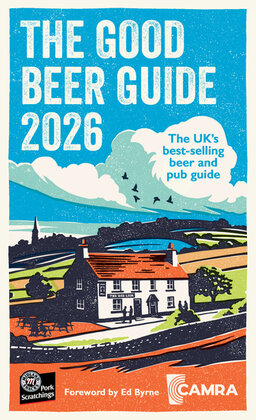Beer Quality Scoring and the Good Beer Guide

Have you ever wondered about how pubs get into the Good Beer Guide (GBG)? Unlike those guides where paid individuals submit reviews, GBG entries are compiled from beer quality scores submitted by CAMRA members. Every single CAMRA member has the opportunity to contribute to the GBG, by submitting quality scores (using the National Beer Scoring System) for the beers they have drunk.
So how do you submit them?
The easiest way is to log onto CAMRA's CAMRA Expeirence The default login details are your CAMRA membership number (without any leading zeroes) as username and the password you created at the time of signing-up. If you have difficulty logging in, there’s help on the screen. In fact, there’s plenty of help for all steps in getting your pub scores entered! It’s up to you how you record your scores while in the pub - scraps of paper, notebooks, or on a smartphone, whatever suits you.
While the concept of sitting at the bar with a notebook giving your beer a points score might seem a little obsessive, in fact beer scoring is a vital tool of CAMRA's ongoing campaign for good beer and good pubs. There are almost 200 pubs in our branch so we need members from across the region to help us gather information about them year-round.
The scores are for quality of cellarmanship, i.e. how well the beer is kept and served.
Scoring is on an 11 point scale (0-5, by half-mark):
0 = No cask ale available
1 = Beer that is anything from barely drinkable to drinkable with considerable resentment. Includes beer taken back as being poor and not subsequently taken off sale.
2 = Competently kept; drinkable but doesn't inspire in any way. Below what is expected for the GBG.
3 = Beer is in good form. A GBG user (i.e. you!) would not be disappointed with it. You may order the beer again in the same session.
4 = Very good: Beer is in excellent condition. Exceeds expectations.
5 = Probably the best kept example of the beer you are likely to find. A seasoned drinker will award this score very rarely.
It’s important to stress that you are scoring the quality of the cellarmanship and not the quality of brewing or whether the beer is to your taste. Don't give a pint 5 just because it’s (say) Doom Bar and you happen to like Doom Bar (or vice-versa, scoring Doom Bar a 2 just because you don't happen to care for it). Think: in your experience is this beer in front of you a really good example of a Doom Bar, or a pretty poor one? And don't score a beer 1 because it’s a stout and you happen to hate stouts. If in doubt, don’t score, or maybe ask a friend what they think. Most people can tell the difference between a beer that just happens to have a flavour that "isn't for them" and a beer with actual defects.
Gradually, as you walk around pubs, you’ll accumulate scores and begin to develop your own method of making comparisons. It’s like riding a bike. Soon it becomes second nature. Some people do find beer scoring confusing and are unsure as to the ‘correct way’ to record a beer score. But you don’t need to be particularly knowledgeable about every beer you might come across! The great thing about real ale is the diversity of tastes.
What should I consider when evaluating an ale?
1. Look: Assess the clarity and the foam of the pint. As a general rule of thumb it’s best to base your view on whether it looks appealing.
2. Smell: Take a short sniff of your drink to assess the aroma. It should encourage you to drink the beer and have no hint that the beer might be stale.
3. Taste: Take a sip and let it flow around your mouth before swallowing. Beers can reflect many taste sensations. The intensity of the flavours and the finish (the ‘aftertaste’) make up the whole taste. Give your taste buds a few seconds to register all the differing sensations. Has the publican kept the beer well enough to allow the flavour to come through fully?
4. Mouthfeel: How does it ‘feel’ in the mouth? Most well-kept ales will have a light carbonation. They should be served at cellar temperature – that means cool, not too cold.
With thousands of ales to choose from, everyone has their own personal favourites and things that they don't like, but please try to give an honest and objective account of how well-kept a particular beer is. If you aren't sure then try to do your scoring based on beers that you know that you normally like when they are in good condition.
So much for submitting the scores, what happens next?
All the scores recorded for our local pubs (from any CAMRA Member) are loaded into a spreadsheet for analysis. If a pub has scores provided for it during the calendar year by at least three different people on different days, and its average score is sufficiently high, then it becomes eligible for consideration as an entry in the Good Beer Guide. The cut-off average score for consideration this year was just over 3.5 out of 5, but it will vary slightly from year to year to keep the numbers at the next stage manageable.
Pubs that are eligible for consideration are then surveyed by a branch member using a standard form. At the Good Beer Guide selection meeting for our branch the survey reports are briefly presented and discussed, followed by a vote using a pre-prepared ballot paper to decide on the entries.
There is a strict allocation of entries, so we are only allowed to submit 6 pubs for the Royal Borough of Kingston and 13 pubs in the rest of our area in Surrey. Occasionally one or two extra pubs will get in if surrounding branches don’t fill their allocation.
So, your vote does count. Judging the best pubs in Britain is something you are uniquely placed to do. Please take the time to beer score and make your contribution to the Good Beer Guide!

